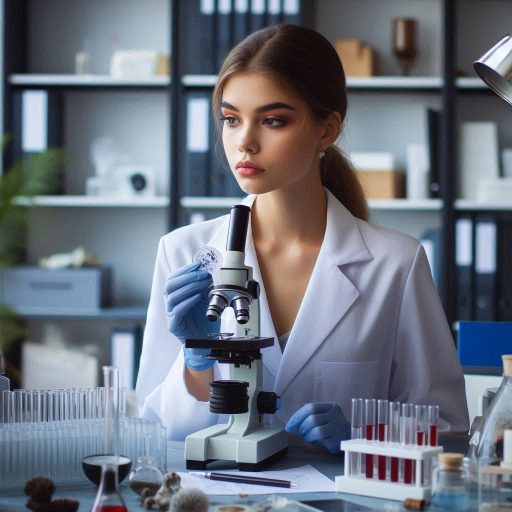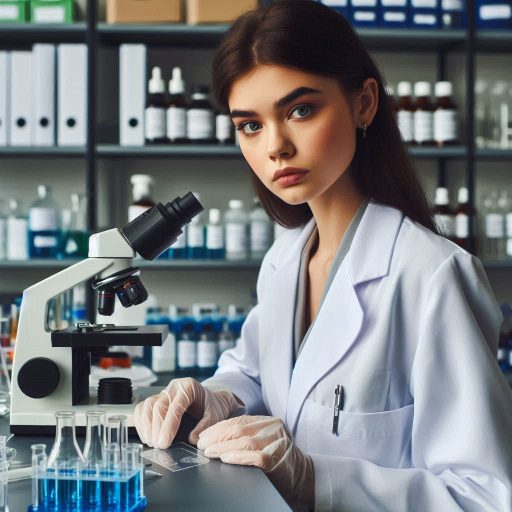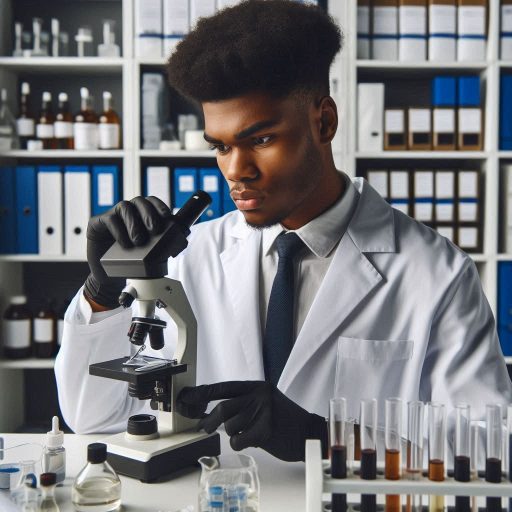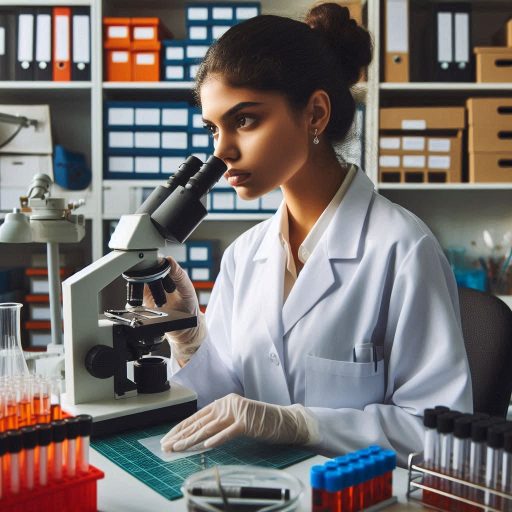Introduction
Forensic science plays a crucial role in solving crimes by using scientific methods to gather and analyze evidence.
Despite its importance, there are many misconceptions surrounding this field that need to be addressed.
One of the most common myths about forensic science is that it is always portrayed accurately in TV shows and movies.
In reality, the process is much more complex and time-consuming than what is depicted on screen.
Another misconception is that forensic evidence is always foolproof and can definitively prove a person’s guilt or innocence.
In truth, forensic evidence is just one piece of the puzzle and must be carefully interpreted within the context of the case.
There is also a misunderstanding about the infallibility of forensic experts.
While they are highly trained professionals, they are still human and can make mistakes.
It is important to acknowledge that forensic science is not immune to errors.
Furthermore, the idea that forensic evidence alone can solve a case is misleading.
In reality, a successful investigation often relies on a combination of forensic evidence, witness testimony, and other factors to build a solid case.
As we delve deeper into the world of forensic science, it becomes apparent that separating fact from fiction is essential.
By debunking myths and shedding light on the reality of this field, we can gain a better understanding of its true significance in the criminal justice system.
Myth: Forensic Science is Just Like What We See on TV Shows
Popular TV Shows Such as CSI and Their Portrayal of Forensic Science
Popular TV shows like CSI often glamorize forensic science, making it seem fast and glamorous.
Viewers watch characters solve crimes in an hour, using cutting-edge technology and perfect techniques.
These shows portray forensic scientists as quick problem solvers who work miracles.
However, real-life forensic science is far from what we see on TV.
The Differences Between Fictional Depictions and Real-Life Forensic Science Practices
In real life, forensic investigations are time-consuming and methodical.
Unlike TV, where evidence is analyzed in minutes, actual processes take days, weeks, or even months.
For example, DNA analysis, often showcased as immediate, can take weeks to yield accurate results.
Labs handle a massive backlog of cases, slowing down the process even more.
Another key difference is that forensic scientists rarely work directly at crime scenes, as often depicted.
On CSI, characters collect evidence, analyze it, and make arrests.
In reality, these roles are divided.
Crime scene investigators collect the evidence, and forensic scientists work in labs to analyze it.
Real forensic scientists don‘t carry guns or chase suspects; their focus remains on research and analysis.
One common fictional technique seen on TV is the use of instant fingerprint matches.
TV shows often exaggerate how quickly and easily fingerprints can be matched.
In reality, fingerprint matching requires a detailed analysis of multiple points, often involving both automated systems and human experts.
It‘s not a simple click of a button, but rather a meticulous, time-consuming process.
Additionally, CSI and similar shows frequently display unrealistic technology.
Fictional labs are shown using fancy 3D holograms or magical software to reconstruct crime scenes.
In reality, the technology used in forensic science is much simpler and practical.
Tools like gas chromatography or blood spatter analysis are effective, but not as visually exciting as their fictional counterparts.
Examples of Real Forensic Techniques Used in Investigations
One real forensic technique used in investigations is bloodstain pattern analysis.
Investigators analyze the shape, size, and distribution of bloodstains to determine how an injury occurred.
This scientific method helps reconstruct the events at a crime scene.
Another common technique is the use of forensic toxicology to detect substances in biological samples.
Unlike on TV, results take time and require detailed reporting.
In short, TV shows present a highly dramatized and simplified version of forensic science.
Real-life forensic work is more methodical, requires collaboration, and involves techniques grounded in science.
While the shows are entertaining, they offer a distorted view of how forensic investigations actually unfold.
Read: Challenges and Rewards: The Dual Life of an U.S. Environmental Scientist
Reality: Forensic science is a diverse field with various specialties
The Different Branches of Forensic Science, Including Forensic Biology, Forensic Anthropology, Forensic Toxicology, etc
Forensic science is not a single discipline but a diverse field made up of various specialized branches.
Each branch plays a vital role in solving crimes and providing essential evidence in court.
One of the key branches is forensic biology, which involves analyzing biological materials such as blood, hair, and DNA.
Forensic biologists examine these samples to identify suspects, victims, or even establish a connection between the crime scene and individuals.
DNA analysis, in particular, has revolutionized forensic science, helping solve cold cases and exonerate innocent people.
Another crucial branch is forensic anthropology, where experts study human skeletal remains.
They determine the age, gender, and identity of the deceased, especially in cases involving unidentified bodies.
Forensic anthropologists also analyze bone injuries to understand the cause of death or reconstruct the crime scene.
Forensic toxicology focuses on identifying drugs, alcohol, poisons, and other toxic substances in biological samples like blood and urine.
This specialty is essential in cases involving drug overdoses, poisonings, or impaired driving.
Toxicologists provide insight into the role substances played in a crime or death.
Forensic pathology deals with determining the cause and manner of death by performing autopsies.
Forensic pathologists provide critical information on how a person died, whether by natural causes, accident, suicide, or homicide.
Their findings often serve as direct evidence in homicide cases.
Meanwhile, forensic chemistry examines non-biological materials like gunshot residue, explosives, or chemicals found at crime scenes.
Chemists in this field can determine the composition of unknown substances, trace the source of explosives, or link materials to a suspect.
Forensic entomology involves studying insects and their life cycles to estimate the time of death.
Insects colonize bodies in predictable patterns, helping forensic entomologists determine how long someone has been deceased.
Digital forensics has become increasingly important in the age of technology.
Experts in this field recover, analyze, and preserve digital evidence from computers, smartphones, and other electronic devices.
How Each Specialty Plays a Unique Role in Solving Crimes and Providing Evidence in Court
Each specialty contributes unique insights to crime investigations.
Forensic biologists use DNA to identify suspects, while anthropologists work to identify remains.
Toxicologists explain the influence of drugs and poisons, and chemists trace materials like explosives to sources.
Digital forensics uncover critical evidence in online crimes, and entomologists establish death timelines.
The Importance of Interdisciplinary Collaboration in Forensic Investigations
Interdisciplinary collaboration is crucial in forensic investigations.
Experts from different fields must work together to solve complex cases.
For example, a forensic biologist might rely on a digital forensics expert to link DNA to online activity.
Each specialty provides critical pieces, creating a complete picture of the crime.
Forensic science‘s diversity and teamwork are essential for solving crimes and delivering justice.
criminal cases.
Collaboration among experts is essential for providing accurate and reliable evidence in court.
Read: Job Market Trends: Future of Chemistry Jobs in America
Myth: Forensic Evidence is Always Conclusive
Many people believe forensic evidence provides absolute certainty in criminal investigations.
However, this belief is misleading.
Forensic evidence can often be inconclusive and does not guarantee definitive outcomes.
Understanding the complexities surrounding forensic evidence is crucial for grasping its role in the justice system.
Forensic Evidence is Not Always Definitive
Forensic evidence, such as fingerprints, DNA, and ballistics, is critical in solving crimes.
Yet, it is not infallible.
Various factors can influence the reliability of this evidence.
Contamination is one significant issue.
A crime scene can become compromised if investigators or bystanders touch evidence or alter the environment.
Such contamination can lead to false conclusions.
Factors Affecting Reliability
Human error also plays a role in the reliability of forensic evidence.
Forensic analysts, despite their expertise, can make mistakes.
Misinterpretation of evidence can occur due to fatigue, pressure, or cognitive biases.
For instance, two analysts might reach different conclusions based on the same evidence.
This inconsistency highlights the subjectivity involved in forensic analysis.
Technological limitations further complicate the reliability of forensic evidence.
While advancements in technology have improved forensic methods, they still have constraints.
For example, DNA testing is powerful but not foolproof.
Factors like degraded samples or mixed DNA profiles can lead to ambiguous results.
These complexities demonstrate that forensic evidence can lack clarity, contrary to popular belief.
Examples of Forensic Evidence in Cases
Numerous cases illustrate the challenges of relying solely on forensic evidence.
In the 1999 case of Gary Dotson, forensic evidence initially led to his wrongful conviction for rape.
DNA evidence later exonerated him, highlighting the limitations of forensic methods.
This case underscores how forensic evidence can mislead and lead to devastating consequences.
Conversely, forensic evidence can play a pivotal role in securing convictions.
In the 2001 case of the “Green River Killer,” DNA evidence linked Gary Ridgway to multiple murders.
Forensic analysis provided critical information that ultimately helped law enforcement apprehend him.
This example demonstrates the importance of forensic science, even if it is not always conclusive.
In summary, the belief that forensic evidence is always conclusive is a myth.
Factors such as contamination, human error, and technological limitations can affect its reliability.
Understanding these nuances is essential for appreciating the role of forensic evidence in the criminal justice system.
It is vital to view forensic evidence as a tool, not a definitive answer.
Read: Challenges and Rewards: Navigating the Chemist Career Path

Reality: Forensic Scientists Follow Strict Protocols and Standards
Forensic scientists play a crucial role in the justice system.
They analyze evidence from crime scenes, providing vital insights that can influence investigations.
To achieve this, forensic scientists undergo rigorous training and education.
Typically, they hold a bachelor‘s degree in forensic science, biology, chemistry, or a related field.
Many pursue advanced degrees to deepen their expertise and enhance their career prospects.
The Rigorous Training and Education Required to Become a Forensic Scientist
Their education includes specialized coursework in chemistry, biology, and forensic techniques.
Students learn about evidence collection, preservation, and analysis.
They also study crime scene investigation and legal aspects of forensic work.
This comprehensive training equips them with the necessary skills to handle complex investigations.
Additionally, many forensic scientists complete internships to gain practical experience in real-world settings.
The Importance of Adherence to Quality Control Measures and Ethical Guidelines in Forensic Investigations
In addition to formal education, forensic scientists must adhere to strict quality control measures.
These measures ensure the accuracy and reliability of their analyses.
Forensic labs implement standard operating procedures (SOPs) to guide their practices.
These SOPs detail every step of the forensic process, from evidence collection to reporting results.
Following these protocols minimizes the risk of contamination or errors.
Quality control measures also include regular proficiency testing.
Forensic scientists must demonstrate their ability to perform analyses correctly and consistently.
Labs often participate in external audits to assess compliance with established standards.
Such assessments help maintain the integrity of forensic results and bolster public confidence in the justice system.
Ethical guidelines further underscore the importance of accountability in forensic science.
Forensic scientists must remain impartial and objective in their work.
They must report their findings honestly, regardless of external pressures.
Adhering to ethical standards protects the integrity of investigations and upholds the principles of justice.
The Role of Accreditation Bodies in Ensuring the Reliability and Validity of Forensic Evidence
Accreditation bodies play a significant role in ensuring the reliability and validity of forensic evidence.
Organizations like the American National Standards Institute (ANSI) and the International Organization for Standardization (ISO) set rigorous standards for forensic laboratories.
These bodies evaluate labs based on their adherence to established protocols and quality control measures.
Accreditation signifies that a lab meets high-quality standards, enhancing the credibility of its findings.
Generally, forensic scientists follow strict protocols and standards that ensure the integrity of their work.
Their rigorous training prepares them for the complexities of forensic analysis.
By adhering to quality control measures and ethical guidelines, they uphold the justice system.
The role of accreditation bodies further emphasizes the importance of reliability in forensic science.
Together, these elements contribute to the effectiveness and trustworthiness of forensic investigations.
Read: Diverse Career Paths: From Chemist to Patent Attorney in the US
Uncover the Details: Networking Tips for Materials Science Professionals
Transform Your Career Today
Unlock a personalized career strategy that drives real results. Get tailored advice and a roadmap designed just for you.
Start NowMyth: Forensic science can solve any crime with absolute certainty
Forensic science is often portrayed in movies and TV shows as a magical tool that can solve any crime with absolute certainty.
However, the reality is far more complex and nuanced than what is depicted on screen.
It is crucial to debunk the myth that forensic science is infallible and can single-handedly solve crimes.
Forensic Evidence is Just One Piece of the Puzzle
Forensic evidence is an important tool in criminal investigations, but it is just one piece of the puzzle.
It should be considered alongside other forms of evidence such as eyewitness testimony, circumstantial evidence, and digital evidence.
Relying solely on forensic evidence can lead to tunnel vision and potentially overlook crucial aspects of a case.
Limitations of Forensic Science
Forensic science has its limitations, including the potential for human error, contamination of evidence, and the subjective nature of some forensic techniques.
For example, fingerprint analysis and handwriting analysis are subjective and open to interpretation.
DNA evidence, while highly accurate, can also be subject to contamination or misinterpretation if not handled properly.
Reliance on Context and Circumstantial Evidence
Forensic evidence is most effective when it is considered in the context of the crime scene and other available evidence.
For example, a single fingerprint at a crime scene may not conclusively prove guilt if there is no other supporting evidence linking the individual to the crime.
Circumstantial evidence, such as motive, opportunity, and behavior, is also crucial in building a case.
Importance of Witness Testimony
Witness testimony can provide valuable insights and corroboration to forensic evidence.
However, witness testimony is not always reliable and can be influenced by factors such as stress, memory distortion, and bias.
It is essential to corroborate witness testimony with other forms of evidence to ensure its accuracy and reliability.
Considering All Available Evidence
Building a solid case requires considering all available evidence, including forensic evidence, witness testimony, circumstantial evidence, and digital evidence.
Each piece of evidence contributes to the overall picture of what happened and must be carefully analyzed and interpreted within the context of the case.
By taking a comprehensive approach to evidence collection and analysis, investigators can build a stronger case and increase the chances of justice being served.
Reality: Forensic Science is Constantly Evolving with Advancements in Technology
Forensic science is a dynamic field that continually adapts to new technological advancements.
Recent developments have significantly impacted how forensic investigations are conducted.
These advancements enhance the accuracy and efficiency of solving crimes.
Recent Technological Developments in Forensic Science
One major breakthrough is DNA profiling.
This technology has revolutionized criminal investigations.
Today, forensic scientists can analyze even tiny samples of biological material.
They can identify suspects with remarkable precision, which helps solve cold cases.
This technology has led to the exoneration of wrongly convicted individuals as well.
Digital forensics is another area experiencing rapid growth.
As technology becomes more integral to our lives, the need to investigate digital evidence has increased.
Forensic experts now recover data from computers, smartphones, and even cloud storage.
They can uncover crucial evidence from deleted files and encrypted communications.
This capability significantly strengthens cases against cybercriminals and assists in various investigations.
Forensic imaging technology has also advanced tremendously.
Techniques such as 3D scanning and reconstruction allow forensic experts to visualize crime scenes in detail.
This technology provides law enforcement with valuable insights into how a crime occurred.
It can help juries better understand complex cases, leading to fairer trials.
How These Advancements Have Improved the Accuracy and Efficiency of Forensic Investigations
While these advancements improve forensic science, they also raise ethical concerns.
For example, DNA databases can aid investigations but may infringe on privacy rights.
Storing genetic information raises questions about who has access to this data.
Authorities must balance public safety with individual privacy to maintain trust in the justice system.
Similarly, digital forensics faces its own ethical dilemmas.
Law enforcement may access personal devices without consent during investigations.
This practice can lead to misuse of sensitive information.
Transparency and guidelines are crucial to ensure ethical use of digital evidence.
Forensic imaging also presents challenges.
The technology requires extensive training and resources.
Misinterpretation of images can lead to wrongful conclusions.
Therefore, continuous education and strict protocols are vital to minimize errors.
Potential Ethical Concerns and Challenges Associated with New Forensic Technologies
The evolving landscape of forensic science holds great promise.
Advancements in technology significantly enhance the accuracy and efficiency of forensic investigations.
As law enforcement agencies adopt these technologies, the potential for solving crimes increases.
However, it is essential to remain vigilant about the ethical implications.
Addressing concerns related to privacy and misuse of information is crucial.
By fostering responsible practices, forensic science can continue to evolve while upholding ethical standards.
The journey of forensic science will undoubtedly shape the future of criminal justice.
served ethically and fairly.
Gain More Insights: Marine Biologist Career Pros and Cons
Conclusion
Forensic science is often portrayed in TV shows and movies as a magical solution to crime, but in reality, it has its limitations.
Many myths exist about forensic science that can mislead the public.
One common myth is that forensic evidence is always foolproof and can solve any crime.
In truth, forensic evidence is just one piece of the puzzle and must be interpreted within the context of the case.
Another myth is that forensic results are always immediate.
However, in reality, forensic analysis can be time-consuming and may take weeks or even months to produce results.
There is also a misconception that forensic scientists are like those seen on TV, conducting all aspects of an investigation.
In truth, forensic science is a team effort involving various experts in different fields.
It is important to dispel these myths and have a realistic understanding of forensic science.
By debunking these misconceptions, we can have a more accurate perception of the capabilities and limitations of forensic evidence.
In essence, it is crucial to educate the public about the realities of forensic science.
By understanding the true nature of forensic evidence, we can ensure that justice is served more effectively.
It is vital to seek accurate information and stay informed about the real practices of forensic science to make informed decisions.
[E-Books for Sale]
The Big Book of 500 High-Paying Jobs in America: Unlock Your Earning Potential
$19.99 • 500 High-Paying Jobs • 330 pages
Explore 500 high-paying jobs in America and learn how to boost your career, earn more, and achieve success!
See All 500 High-Paying Jobs of this E-Book
1001 Professions Without a Degree: High-Paying American Jobs You Can Start Now
$19.99 • 1001 Professions Without a Degree • 174 pages
Discover 1001 high-paying jobs without a degree! Unlock career tips, skills, and success strategies for just $19.99!




